 Awe and wonder surround the spectacular phenomenon of colour change in gemstones. The fascination of seeing colours shift before one’s eyes can leave consumers speechless with utter disbelief.
Awe and wonder surround the spectacular phenomenon of colour change in gemstones. The fascination of seeing colours shift before one’s eyes can leave consumers speechless with utter disbelief.
These rarities are chameleons of the gemstone world, coveted for their ability to change colours in different light.
The human eye perceives light in the visible spectrum, comprised of red, orange, yellow, green, blue and violet wavelengths. Colour change gemstones have two transmission windows in the visible spectrum of roughly equal size, and the nature of the illumination dictates the perceived colour.
Alexandrite is a fine example of this magical effect, with superior quality material producing a dramatic shift that is sometimes described as ‘emerald by day and ruby by night’; fittingly, the ‘magician’ in this extraordinary colour play is none other than chromium, the element responsible for the rich red of rubies and the vivid green in emeralds.
A member of the chrysoberyl family, alexandrite contains traces of chromium +3 ions. These ions react to light and absorb specific parts of the light spectrum giving the resulting colour.
Natural daylight or fluorescent light contains higher proportions of blue and green wavelengths and will cause the gemstone to appear to be green whereas incandescent lighting, such as an electric globe that contains a higher proportion of red wavelengths, will cause the gemstone to appear red.
This mineral’s light-absorbing quality doesn’t end with colour change; alexandrite also exhibits strong trichroism, showing different colours when viewed from different directions.
The gemstone was first discovered in Russia’s Ural Mountains in the 1830s, but current sources include Sri Lanka, East Africa, India and Brazil.
The attractive gemstones produced from Russian deposits in the 19th century are still considered to be the most distinctive, displaying vivid hues and bold colour changes. Modern sources of alexandrite tend to exhibit muddier tones with a less-precise colour change.
Garnet, sapphire and spinel
Rare colour change sapphires exist, with the varying colours dependent on the colouring agents. The more commonly seen and popular gemstones are from Sri Lanka, and shift from purple under incandescent light to bluish violet in daylight.
A well-kept secret is Australian colour change sapphires from the central Queensland gemstone fields that display some unusual colour changes – brown to green, yellow to pink, or golden orange to orangey-green.
Rivalling alexandrite and sapphire for hardness and durability is colour change spinel. This chameleon can change from blue to purple or from light bluish-violet to light pink, resembling colour change sapphire without the hefty price tag.
Colour change garnets are another rare occurrence, with limited deposits in Sri Lanka, Tanzania and Madagascar. Fine quality gemstones can produce a strong and attractive red to green colour change, rivalling that of alexandrite.
Colour change garnet is usually either pyrope type or a mixture of pyrope and spessartite varieties.
The presence of varying amounts of chromium and/ or vanadium can produce a colour change that flashes from reddish-purple to a steely blue, green or greyish tone. Other possible colour combinations are reddish-orange to red, greenish- yellow to pinkish-red, light-red to purplish-red and bluish-green to light violet-purple.
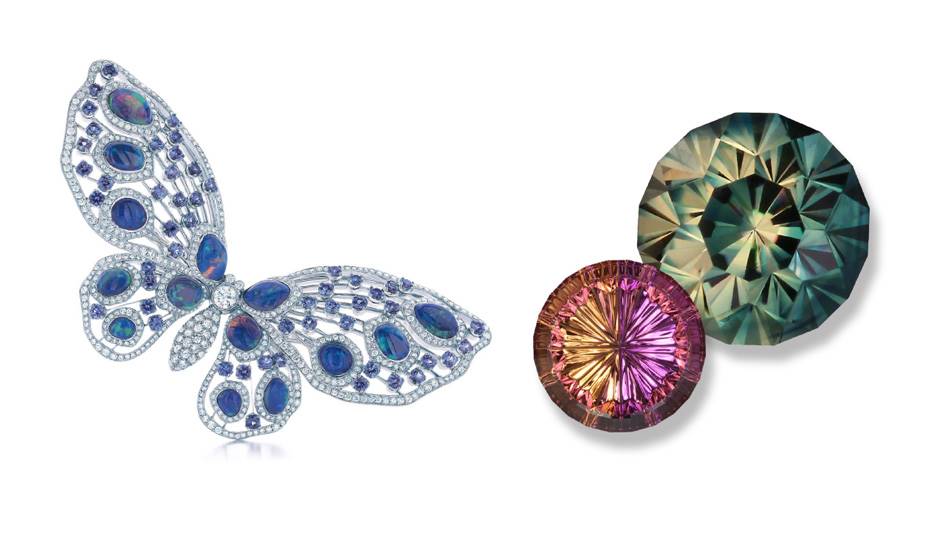 |
| From Left to Right: Tiffany & Co.; John Dyer |
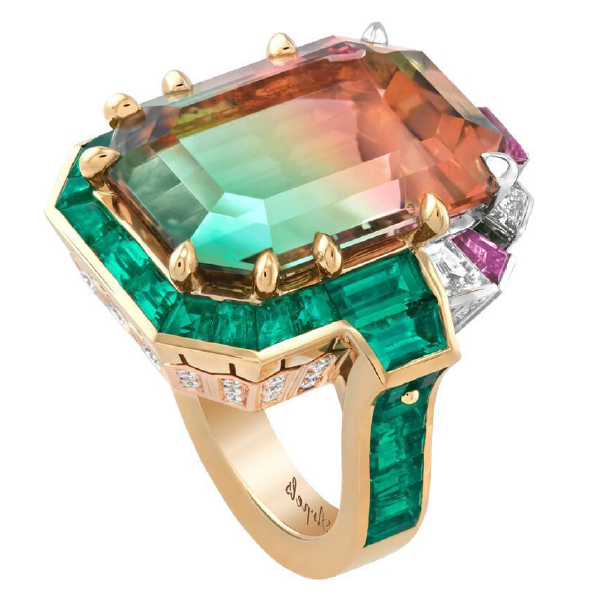 |  | 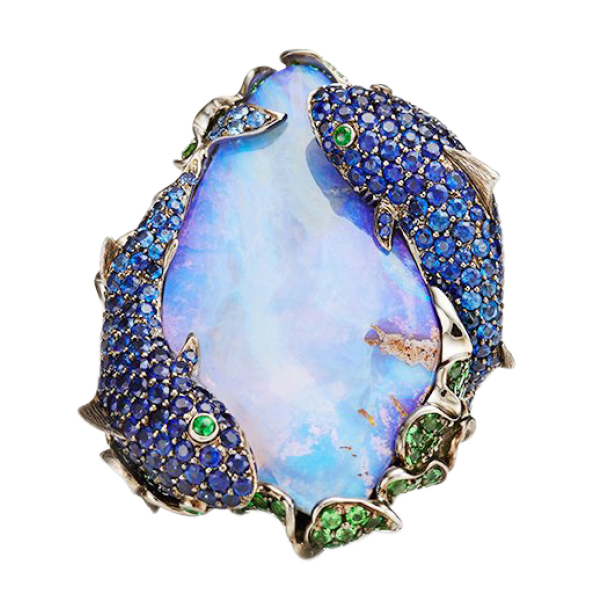 |
Above: Harry Winston | Above: Irene Neuwirth | Above: Lydia Courteille |
Diaspore
Rounding out the top colour-change gemstones is colour-change diaspore; called “a true Turkish delight” by the International Colored Gemstone Association (ICA), gem-quality specimens were discovered in the Turkish Anatolian Mountains in the 1970s at heights of more than 1,200m (4,000 feet).
Natural and untreated, high-quality colour-change diaspore has been sold under various trade names, all referencing the Sultans, Tsars and Ottomans of Turkey – these names include zultanite, csarite and ottomanite.
Diaspore’s first patented trade name, zultanite, was registered in 2005 by Turkish jeweller Murat Akgun in honour of the 36 sultans who ruled the Ottoman empire from 1299 to 1923.
Regal associations are certainly befitting this exotic, pastel-toned gemstone coloured by manganese. Traces of chromium in the presence of iron causes colour changes depending on the light.
What appears as kiwi green with flashes of yellow in sunlight might seem raspberry or brownish pink under candlelight, champagne in incandescent light, and something else entirely in other light sources.
Another feather in diaspore’s cap is a property known as trichroism. These colours – brownish pink, yellowish green and sometimes violet blue – are distinct and contribute towards its colour-change effect.
A factor impacting the value and availability of colour-change diaspore is its tendency to cleave, which presents a challenge for the cutter. Yield rates are notoriously low and can be as little as 2 per cent for eye-clean material and 10 per cent for larger sizes; consequently, large, clean and well-cut gemstones are extremely rare and expensive.
Opal and ammolite
Like colour-change diaspore, ammolite is also exclusively found in one location – a region in the Rocky Mountains of North America.
Ammolite forms when the fossilised shell of ammonites – now- extinct marine invertebrate animals – are preserved and the cavities that originally held the soft body are filled with aragonite, the same mineral that is responsible for the nacre of pearl oyster shells.
The ammonites that form ammolite specifically inhabited a prehistoric inland subtropical sea that bordered the Rocky Mountains; as the sea receded, layers of sediment preserved the shells.
The resulting organic gem – which resembles an opal in some ways – is beautifully coloured, with a wonderfully vivid iridescent sheen. This sheen is caused by an interference effect, when white light is refracted and reflected back from the layered aragonite platelets within the gem’s structure.
The thicker these layers, the more red and green hues are seen; when layers are thinner, violet and blue hues dominate.
The pattern, intensity and range of colour all contribute to the overall value of an ammolite gem. Green and red are the most common colours, with blue and violet being rarer, and therefore more valuable.
Ammolite may be described as either fractured or sheet. Sheet ammolite is unbroken, with a continuous movement of colour across its surface. Fractured ammolite may have various different patterns and some have been described with terms such as ‘dragon skin’, ‘cobblestone’, ‘moonglow’ and ‘paint brush’.
Opal – Australia’s national gemstone – also displays patterns and play-of-colour, but for different gemmological reasons.
Opal is a form of hydrated silica containing up to 21 per cent water existing as free water within the opal or bonded to other atoms in the structure.
Millenia ago, water carrying weathered particles of silica in saturated solutions soaked through the sandstone ground rock, infilling cracks and cavities left behind from geological movement deep in the ancient bedrock.
The landscape dried as the climate shifted, evaporating water and leaving the silica particles to merge together into a solid state in the form of microscopic silica spheres.
When conditions are ideal, the silica spheres are uniform in size and appear in a stacked structure that is orderly and symmetrical. Small voids occur between the spheres to create an environment where white light can be reflected and diffracted as it enters the opal into different wavelengths.
This results in playful, kaleidoscopic flares known as opal’s play-of-colour.
Although opal’s play-of-colour means the gemstone can produce every hue of the rainbow, this is not always the case. Silica spheres of different sizes result in different colours and violet, blue and green are the most commonly occurring. Rarer and most enticing is red or any opal displaying a full spectral range.
The body colour of opal is caused by trace elements that are present during formation. Iron and titanium oxides typically cause brown-black tones while nickel and chromium can produce green. Other colours include white, yellow, pink, red and blue.
In the end, it is the hue, brightness, pattern and directionality of an opal’s play-of-colour that determines the gemstone’s quality and desirability.
Finding material that displays play-of-colour is rare and this distinctive attribute has made precious opal a highly- sought gemstone.
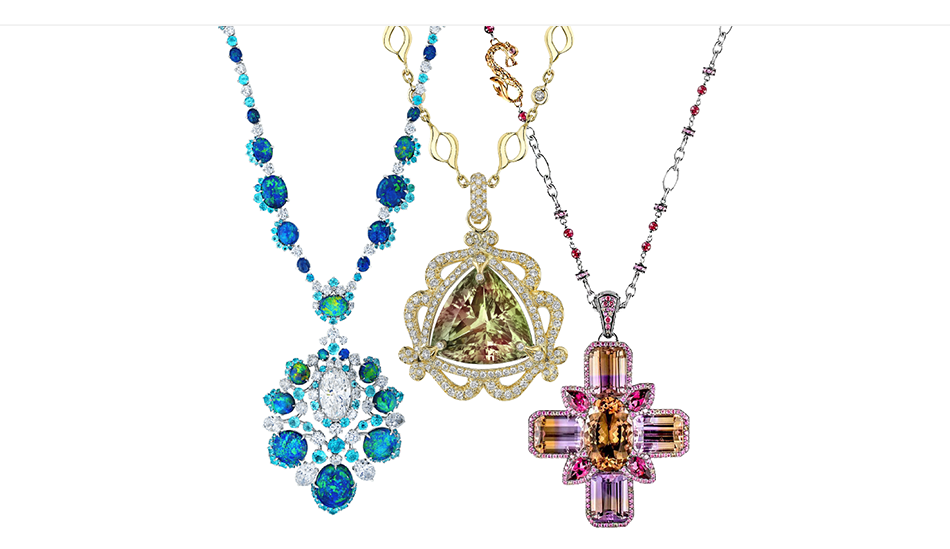 |
| Left to Right: David Morris; Daniel Gibbings; John Hardy |
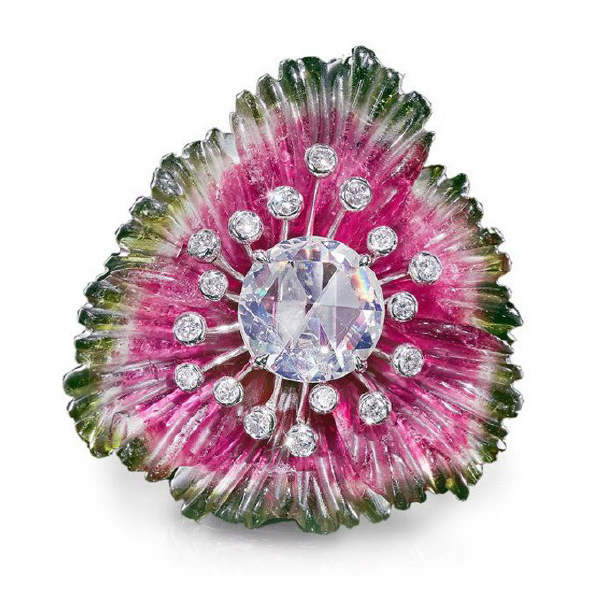 | 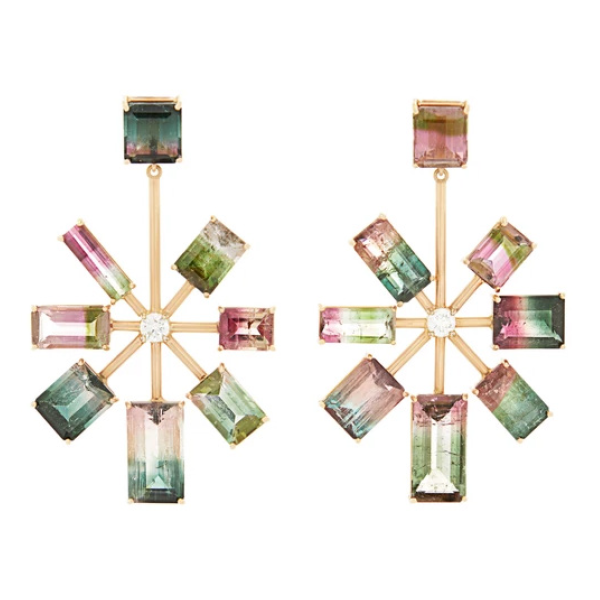 |  |
Above: Leviev | Above: Irene Neuwirth | Left to Right: Paolo Costagli; Katherine Jetter |
Multi-hued and parti-colour
Last but certainly not least are polychromic gemstones – those that display multiple body colours due to crystalline structural changes during the growth process caused by exposure to different chemical elements, radiation, or heat. The most well-known are parti-colour sapphires, ametrine, and watermelon tourmaline.
Tourmaline occurs in a seemingly endless variety of hues and may also be found with different colours in different parts of the crystal. Some gem deposits produce crystals that have one colour in the core of the crystal encircled by differently coloured layers.
Such stones are often cut as slices with perhaps the most desirable being watermelon tourmaline, which has a pink core and a green rim.
Parti-colour sapphires are similarly desirable. Primarily found in Australia, the most common combination is bright yellow and green.
More rarely, blue, purple, or lavender shades can be found, which usually originate from the famous sapphire mines of Montana in the US.
Kenyan parti-colour sapphires are also highly valued, and usually display more greenish tones, rather than yellow.
The hues in a parti-colour sapphire develop based on the chemical elements present in the crystal; iron imparts a yellow colour, while blue and green are the result of different ratios of titanium and iron.
Green-blue parti-colour sapphires can be differentiated from teal sapphires by the distinctive colour zoning, rather than a blended body colour.
Gemstones that display two truly distinct colours in good proportion to each other are rare and are greatly desired by collectors.
Another gemstone displaying dual-colour distinction is ametrine, which marries two well-known gemstones: amethyst and citrine.
Both varieties belong to the quartz family and are coloured by the slight presence of iron impurities. However, the marked difference in the colours of ametrine reflects the dramatic temperature change that occurs during the gemstone’s formation.
Similarly, rare specimens of bi-colour beryl – usually a combination of aquamarine and morganite – have been found, largely in Minas Gerais, Brazil.
Even more rare is bi-colour topaz. Like sapphire and tourmaline, topaz is available in a variety of different natural colours, including blue, brown, orange, green, white (colourless), pink and red.
However, some bi-colour specimens have been found in limited quantities; Brazilian bi-colour topaz tends to show a gradient of pink to orange or deep orange to pale orange, while Russian and Ukrainian bi-colour topaz may show natural blue and tan hues.
The captivating magic of colour change and multi- colour gemstones will far outlive any show, and as prices of conventional gemstones in fine qualities are rising, these exotics present alternatives for those who demand unique, collectible gemstones.
GEMSTONE FOCUS
THE OPULENT OPAL
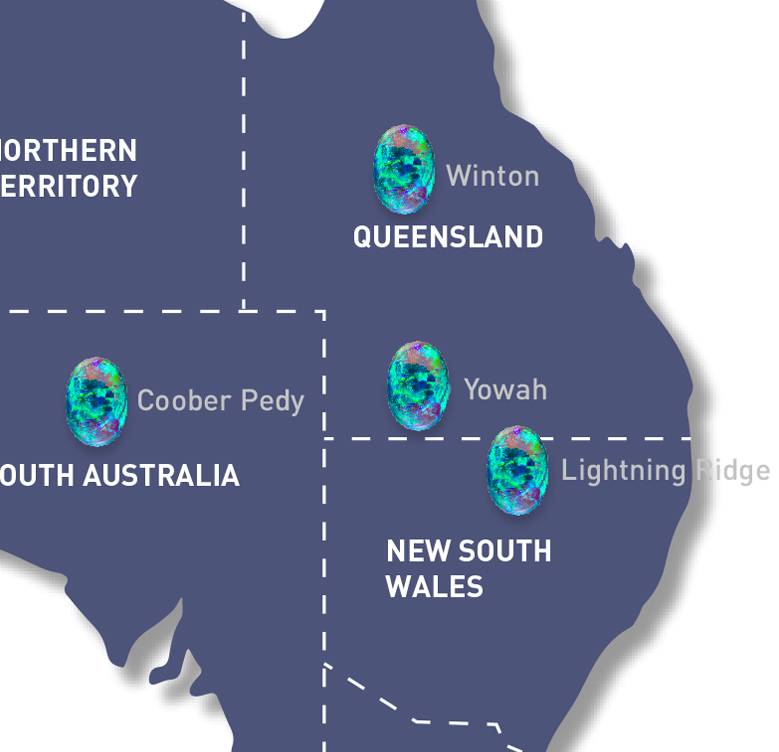
Precious opal is composed of minute uniform spheres of silica, which are arranged together in an orderly three-dimensional grid. The spaces between these spheres contain silica in solution. White light passes through the transparent spheres directly, but when it
reaches the silica in solution, it is deflected at angles. These diffracted beams of light may show all the colours of the spectrum, or particular colours may predominate. The colour from the opal is dependent on the size of the spheres, which determine the wavelengths. For instance, blue colours are evident where the spheres are smaller and, at the other end of the spectrum, orange and red will be evident where the spheres are larger. The intensity and brilliance of the colours are a result of the degree of uniformity of size and regularity of the grid. 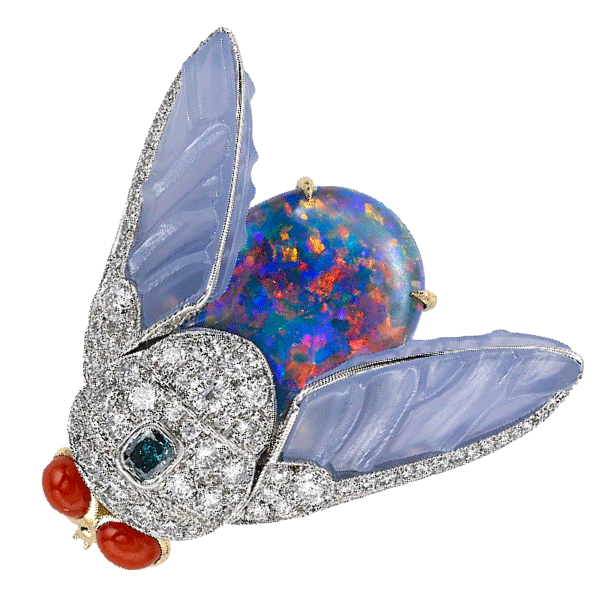 | | Above: George Pragnell |
The value of an opal is determined by the type of opal, the predominant colours it exhibits, the clarity or brilliance of these colours, and the patterns in which the colours are arrayed. Good patterns of diffracted colours have an enormous impact on the value of the opal. Pinfire and small type patterns are more common, and thus less expensive than broad patterns. The major outcrops of opal in Australia occur along the shoreline of what was once The Great Inland Sea. The Queensland fields are spread across 1,000km and produce almost all the world‘s supply of boulder opal. Lightning Ridge produces almost all of Australia’s sensational black opals and, despite a recent decline in production, it is still the largest producer of opal by value. The bulk of the world’s light seam opal has been mined at Coober Pedy. By 2008 Coober Pedy’s production had fallen to 15 per cent of its heyday but this dusty, hot outback town remains home to more than 4,000 people. Source: Cody Opal |
read emag